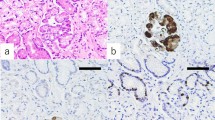Abstract
Purpose
The nature of pancreatic acinar metaplasia (PAM) in the gastro-oesophageal junction (GOJ) remains obscure. We aimed to estimate its prevalence and investigate into its risk factors in a population-based series of first-time endoscopy patients.
Methods
We investigated consecutive patients, endoscoped for the first time, representing defined catchment area populations. Biopsies were taken immediately below the GOJ and from the distal oesophagus. Endoscopy room-based cross-sectional clinical data were supplemented with exposure data from 160 population controls. Associations, expressed as odds ratios (OR), were modelled with multivariable logistic regression. A subsample of 26 patients underwent oesophageal pH monitoring.
Results
Among 644 patients (mean age 53 years, 43% men), PAM was found in 121 patients (19%), exclusively above the GOJ in 40 (6%), below GOJ in 67 (10%), and both above and below GOJ in 14 (2%). PAM exclusively above the GOJ and PAM exclusively below the GOJ were both borderline associated with age (2% increase in prevalence per year). PAM exclusively above the GOJ was significantly associated with female gender (OR 2.8, 95% CI 1.3–6.3) and presence of Helicobacter pylori immediately below the GOJ (OR 2.6, 95% CI 1.3–5.4). Out of 21 patients with Barrett’s oesophagus (BO), 8 (38%) had PAM above the GOJ. The mean value for percentage time with oesophageal pH < 4.0 was 7.3% (95% CI 4.3–10.2%) among patients who had PAM above the GOJ (reference value 3.4%).
Conclusions
Pancreatic acinar metaplasia might be an age-dependent lesion, associated with H. pylori, female gender and gastro-oesophageal reflux if located above the GOJ.


Similar content being viewed by others
References
Doglioni C, Laurino L, Dei Tos AP, De Boni M, Franzin G, Braidotti P, et al. Pancreatic (acinar) metaplasia of the gastric mucosa. Histology, ultrastructure, immunocytochemistry, and clinicopathologic correlations of 101 cases. Am J Surg Pathol. 1993;17:1134–43.
Wang HH, Zeroogian JM, Spechler SJ, Goyal RK, Antonioli DA. Prevalence and significance of pancreatic acinar metaplasia at the gastroesophageal junction. Am J Surg Pathol. 1996;20:1507–10.
Krishnamurthy S, Dayal Y. Pancreatic metaplasia in Barrett’s esophagus. An immunohistochemical study. Am J Surg Pathol. 1995;19:1172–80.
Johansson J, Hakansson HO, Mellblom L, Kempas A, Johansson KE, Granath F, et al. Prevalence of precancerous and other metaplasia in the distal oesophagus and gastro-oesophageal junction. Scand J Gastroenterol. 2005;40:893–902.
Hakansson HO, Mellblom L, Johansson J, Bjartell A, Borgstrom A. Synthesis and localization of pancreatic secretory proteins in pancreatic acinar-like metaplasia in the distal part of the oesophagus. Pancreatic acinar metaplasia: another source of pancreatic enzymes!. Scand J Gastroenterol. 2003;38:10–3.
Jhala NC, Montemor M, Jhala D, Lu L, Talley L, Haber MM, et al. Pancreatic acinar cell metaplasia in autoimmune gastritis. Arch Pathol Lab Med. 2003;127:854–7.
el-Zimaity HM, Verghese VJ, Ramchatesingh J, Graham DY. The gastric cardia in gastro-oesophageal disease. J Clin Pathol. 2000;53:619–25.
Polkowski W, van Lanschot JJ, ten Kate FJ, Rolf TM, Polak M, Tytgat GN, et al. Intestinal and pancreatic metaplasia at the esophagogastric junction in patients without Barrett’s esophagus. Am J Gastroenterol. 2000;95:617–25.
Johansson J, Hakansson HO, Mellblom L, Kempas A, Johansson KE, Granath F, et al. Risk factors for Barrett’s oesophagus: a population-based approach. Scand J Gastroenterol. 2007;42:148–56.
Miller LS. Endoscopy of the esophagus. In: Castell DO, editor. The esophagus. Boston: Little, Brown & Co; 1992. p. 89–142.
Armstrong D, Bennett JR, Blum AL, Dent J, De Dombal FT, Galmiche JP, et al. The endoscopic assessment of esophagitis: a progress report on observer agreement. Gastroenterol. 1996;111:85–92.
Falk GW. Barrett’s esophagus. Gastroenterology. 2002;122:1569–91.
Lagergren J, Bergström R, Lindgren A, Nyrén O. Symptomatic gastroesophageal reflux as a risk factor for esophageal adenocarcinoma. N Engl J Med. 1999;340:825–31.
Kjellen G, Brudin L, Hakansson HO. Is scintigraphy of value in the diagnosis of gastrooesophageal reflux disease? Scand J Gastroenterol. 1991;26:425–30.
Johnsson F, Joelsson B, Isberg PE. Ambulatory 24 hour intraesophageal pH-monitoring in the diagnosis of gastroesophageal reflux disease. Gut. 1987;28:1145–50.
Bland M. An introduction to medical statistics. 3rd ed. Oxford: Oxford University Press; 2000.
Glickman JN, Fox V, Antonioli DA, Wang HH, Odze RD. Morphology of the cardia and significance of carditis in pediatric patients. Am J Surg Pathol. 2002;26:1032–9.
Malfertheiner P, Sipponen P, Naumann M, Moayyedi P, Megraud F, Xiao SD, et al. Helicobacter pylori eradication has the potential to prevent gastric cancer: a state-of-the-art critique. Am J Gastroenterol. 2005;100:2100–15.
Hagiwara T, Mukaisho K, Ling ZQ, Sugihara H, Hattori T. Development of pancreatic acinar cell metaplasia after successful administration of omeprazole for 6 months in rats. Dig Dis Sci. 2007;52:1219–24.
Spechler SJ. Intestinal metaplasia at the gastroesophageal junction. Gastroenterology. 2004;126:567–75.
Acknowledgments
This study was funded by a grant from the Swedish Cancer Society (4570-B01-01XAB), by the Health Research Council in the South-East of Sweden (F97-310 and F2001-334), by the Department of Surgery, Kalmar County Hospital and by Kalmar County Council Research and Development Committee, Sweden. We express our gratitude to Susanne Kjellin and Gun Olsén for coordination of the endoscopies, to Agneta Hansson for data input, to Joakim Vang for database design, and to Professor Anders Borgström and Dr. Erik Svartholm for valuable discussions during the planning and early phase of the study.
Author information
Authors and Affiliations
Corresponding author
Rights and permissions
About this article
Cite this article
Johansson, J., Håkansson, HO., Mellblom, L. et al. Pancreatic acinar metaplasia in the distal oesophagus and the gastric cardia: prevalence, predictors and relation to GORD. J Gastroenterol 45, 291–299 (2010). https://doi.org/10.1007/s00535-009-0161-4
Received:
Accepted:
Published:
Issue Date:
DOI: https://doi.org/10.1007/s00535-009-0161-4



